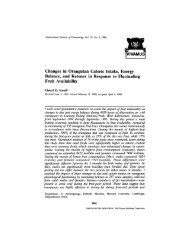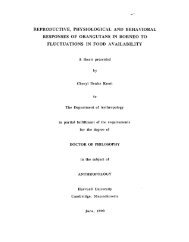Saving Gunung Palung: A Rainforest Marriage - Cheryl Knott
Saving Gunung Palung: A Rainforest Marriage - Cheryl Knott
Saving Gunung Palung: A Rainforest Marriage - Cheryl Knott
- No tags were found...
Create successful ePaper yourself
Turn your PDF publications into a flip-book with our unique Google optimized e-Paper software.
<strong>Saving</strong> <strong>Gunung</strong> <strong>Palung</strong>continued from previous pagesome action,” <strong>Knott</strong> adds. “But [the studysite is] in danger of being shut down. Thereare only about three orangutan researchsites in the world now.” Others have beenclosed, either because there is too little forestleft, or because the presence of loggersmakes it impossible—and dangerous—towork.Congress has helped by passing theGreat Ape Conservation Act, signed intolaw in 2000. It provides about $5 million ayear to support the conservation and protectionof great apes by giving grants tolocal wildlife management authorities andother organizations involved in the effortto protect the animals and their habitat.<strong>Knott</strong>’s organization in <strong>Gunung</strong> <strong>Palung</strong> hasreceived support from this fund, and sheurges people to contact their Congressmember about continuing or even increasingsupport.Consumers can also buy “environmentallycertified wood,” which lets themknow that the wood they’re buying did notcome from rainforests. Woods like Asianmahogany and lauan (used in inexpensiveplywood) are among the many types foundin Indonesian rainforests.“A lot of the public outcry does helppressure the Indonesian officials at thenational level to take action,” <strong>Knott</strong> says.The <strong>Gunung</strong> <strong>Palung</strong> Orangutan ConservationProject put up a petition on its Websiteand received about 8,000 signaturesworldwide to stop illegal logging in thepark.“I think things like that do have animpact,” <strong>Knott</strong> says. “[It] could pressureour leaders to pressure other national governmentsas a condition of internationalaid, for example, to protect forests, toshow they’re really doing something.“The orangutan may be the first greatape to go extinct in the wild,” <strong>Knott</strong> says.“Their trajectory for extinction is greaterthan for chimps or gorillas—they’re themost threatened. You figure 80 percent oforangutan habitat has been lost in the last20 years. It’s just totally shocking that thegreat apes could become extinct.”For more information on the <strong>Gunung</strong> <strong>Palung</strong> NationalPark, go to www.fas.harvard.edu/~gporang.<strong>Knott</strong> and Laman’s fieldwork is good,important, even noble, but it’s definitely noteasy.“You wake up usually at around 3:30a.m.,” says <strong>Knott</strong>. “You need to get to thenest when the orangutan wakes up,[around] 5 a.m. That involves getting therein the dark, so maybe you have to travel foran hour in the forest in the dark, then youfollow them all day till they make a nest atnight.You’re on the ground, watching themup in the trees. Some days they don’t govery far, and it’s really easy. But other days… we’re on the side of a mountain.You’realso often carrying all your gear. So, it’s challenging.You’re running after them, and inthe swamp area you might be up to yourknees in water. When you’re looking forthem it’s better if you can walk fast. It’s definitelyphysical, but it’s not grueling.”Orangutans are arboreal creatures—they live in treetops, in what is called therainforest canopy. So Laman spends muchof his time harnessed to a 200-feet tall tree(higher than the Peabody Museum, to rein-Human Subjects / Humane Researchcontinued from page 5Because she was going to be workingwith human subjects, Hooley soughtapproval from the Committee on the Useof Human Subjects.“Professor Hooley first ran a pilot studywith only six healthy women with no historyof depression,” recounts Calhoun.“Next she tried the same procedure withwomen who had recovered from anepisode of depression. Only then did sheapply to do the study with depressedwomen. Thus, she and the committee [onthe Use of Human Subjects] had quite a bitof information to go on in evaluating possiblerisks to the women. At that point, thecommittee asked for a number of changesand additions. For instance, only womenwho had previously told their mothers oftheir depression could participate and nofreshmen could participate. ProfessorHooley was asked to provide volunteers aLife in the Fieldtroduce an earlier marker) with 30 poundsof equipment in a backpack, watching thewildlife. It’s not hard to see why he wouldbring back amazing photographs, along withbiological data—few people have the staminaor academic background for this kind ofwork.Occasionally, big males will come downto the ground and chase people, though<strong>Knott</strong> and Laman have never been chased.There are other dangers, though.“I’ve been pretty lucky,” <strong>Knott</strong> says.“Butthere’s malaria, Dengue fever, giardia. I hadone student who was hit by a tree branchand it opened her scalp up. She had to besewn up. Someone broke [a] foot oncejumping in the river.There are various accidentsand diseases that you can take medicinefor—although not for Dengue fever.But if you have enough DEET (an insectrepellant) on, you can protect yourself frommosquitoes.”As Laman dryly says, “There’s definitelyan adventure component.”more extensive explanation of the imagingprocess that would be used; to explain tothe mothers as well as the daughters thatthe daughters might become upset whileparticipating and what would be done tohelp them.”This example, Calhoun says, demonstratesthe collaboration between an investigatorand the IRB, which “provided ideasabout some additional measures that couldfurther minimize the risk that anyonewould be upset or harmed by the experienceof participating as a research subject.”Hooley’s research—which was approvedby the IRB—involves playing taped messagesboth of criticism and praise to hersubjects while watching brain activity withthe help of MRI (magnetic resonanceimaging). The goal is to determine if thecontinued on next pageHarvard University10GSAS





